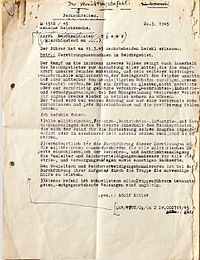Nero Decree

The Nero Decree (German: Nerobefehl) was issued by Adolf Hitler on 19 March 1945, ordering the destruction of German infrastructure to prevent its use by Allied forces as they penetrated deep within Germany. It was officially titled Decree Concerning Demolitions in the Reich Territory (Befehl betreffend Zerstörungsmaßnahmen im Reichsgebiet) and has subsequently become known as the Nero Decree, after the Roman Emperor Nero, who, according to an apocryphal story,[1] engineered the Great Fire of Rome in 64 AD. The decree was deliberately disobeyed by Albert Speer shortly before the fall of the Nazi regime.
Background
[edit]By the beginning of 1945, the situation for Germany was desperate.[2] Most of the conquered territories had been liberated or recaptured, the Ardennes Offensive had failed, and Allied armies were advancing on Germany proper from both the East and the West. However, Hitler was not willing to accept the terms of unconditional surrender, and considered this as repeating the same shame as Versailles.[2] Moreover, according to some around him, Hitler came to view the German people as having failed him, unworthy of their great mission in history and thus deserving to die alongside his regime.[3]
This was not the first time Hitler had tried to destroy infrastructure before it could be taken. Shortly before the Liberation of Paris, Hitler ordered explosives to be placed around important landmarks, such as the Eiffel Tower, and key transportation hubs. If the Allies came near the city, the military governor, General Dietrich von Choltitz was to detonate these bombs, leaving Paris "lying in complete debris".[4] Von Choltitz, however, did not carry out the order and surrendered to the Allies, later alleging that this was the moment he realised that "Hitler was insane". Similarly, Hitler had issued orders to enact a scorched earth policy upon the Netherlands in late 1944, when it became obvious that the Allies were about to retake the country, but Arthur Seyss-Inquart, the Reichskommissar in charge of the Netherlands during its occupation, was able to greatly limit the scope to which the order was executed.[5]
Decree
[edit]The order's most pertinent section reads as follows:
It is a mistake to think that transport and communication facilities, industrial establishments and supply depots, which have not been destroyed, or have only been temporarily put out of action, can be used again for our own ends when the lost territory has been recovered. The enemy will leave us nothing but scorched earth when he withdraws, without paying the slightest regard to the population. I therefore order:
1) All military transport and communication facilities, industrial establishments and supply depots, as well as anything else of value within Reich territory, which could in any way be used by the enemy immediately or within the foreseeable future for the prosecution of the war, will be destroyed.[6]
Actions
[edit]
The decree was in vain. The responsibility for carrying it out fell to Albert Speer, Hitler's Minister of Armaments and War Production. According to him, Speer was appalled by the order and lost faith in the Führer. Just as von Choltitz had several months earlier, Speer deliberately failed to carry out the order. Upon receiving it, he requested to be given exclusive power to implement the plan, instead using his power to convince the generals and Gauleiters to ignore the order. Hitler apparently remained unaware of this until the very end of the war. Speer would later claim that during his last ever meeting with Hitler on 22 April in the Berlin Führerbunker, he admitted to having deliberately disobeyed his instructions.[7] Hitler was allegedly angry with Speer, but allowed him to leave nonetheless. However, Speer's recollection has been disputed by some historians, with Richard J. Evans describing it as "pure invention."[8] Hitler committed suicide on 30 April 1945, forty-two days after issuing the order. Shortly afterwards, on 7 May 1945, General Alfred Jodl signed the German military surrender, and on 23 May Speer was arrested on the orders of U.S. General Dwight D. Eisenhower, together with the rest of the provisional German government led by Grand Admiral Karl Dönitz, Hitler's successor as head of state.
See also
[edit]Notes
[edit]- ^ Publius Cornelius Tacitus. The Annals. Book 15 [15.16]. Archived from the original on 14 April 2009. Retrieved 27 October 2021.
Nero at this time was at Antium, and did not return to Rome until the fire approached his house
{{cite book}}: CS1 maint: location (link) - ^ a b "March 19, 1945: Blow It All Up". Wired. 19 March 2007.
- ^ US Army in WW II: The Last Offensive (Paperback). Government Printing Office. ISBN 978-0-16-089940-9.
- ^ ... Brennt Paris?. Amazon.de. Retrieved 25 August 2008.
- ^ "Judgement : Seyss-Inquart". The Avalon Project.
- ^ Hugh R. Trevor Roper (ed). Blitzkrieg to Defeat: Hitler's War Directives 1939–1945 (NY: Holt Rinehart and Winston, 1971) pp. 206–207
- ^ Hamsher (Wiliam), Albert Speer / Victim of Nuremberg ?, Londres, Frewin, 1970; Schmidt (Matthias), Albert Speer / Das Ende eines Mythos, Munich, Scherz, 1982
- ^ Evans, Richard J. (1997). Rereading German History: From Unification to Reunification 1800-1996. London: Routledge. p. 202. ISBN 978-0-41-515899-2.
